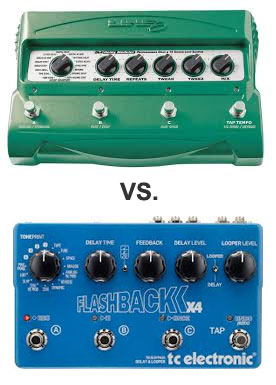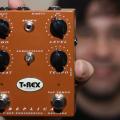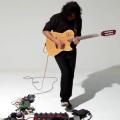The following is a guest post by Jacob Van Paepeghem. If you are interested in guest posting, please contact me!
 *Warning: If you want to simply hear how the Flashback or DL4 sound, I’d recommend any of the 83,784,729 high quality videos out on YouTube. Each pedal has a very distinct tone, but I’m going to be primarily talking about features.
*Warning: If you want to simply hear how the Flashback or DL4 sound, I’d recommend any of the 83,784,729 high quality videos out on YouTube. Each pedal has a very distinct tone, but I’m going to be primarily talking about features.
As a guitar player and reluctantly admitted lifetime gear head, I would say my tastes towards pedals, amp, and guitars has always weighed practicality and utilitarianism over uniqueness. Â And when it comes to delay pedals, those like me now have options.
The Line 6 DL4 has been the standard, affordable, Swiss Army knife for guitar players since its release in 2000. Three presets, tap tempo, 16 echo and delay models, 24 bit stereo processing, and a looper with some fun toys (reverse, half speed).  But its cons have been cause for infuriation for just as long.  There is a significant signal loss at high gain levels (push any kind of high gain overdrive or distortion in front of it, even the untrained ear will notice) , they have a tendency to break often, and the stock switches are very loud, flimsy, and inaccurate.  But even with these issues, the DL4 is the crux of many professional pedal boards (Dave Knudson of Minus The Bear uses TWO on his board, Drew Shirley of Switchfoot with the JHS mods, I could go on and on), which is why I bought one three years ago.
It is amazing to me the in 12 years, Line 6 has not updated the DL4, even once. They have kept the same, neon green, Klingon looking casing, the same effects models, and the same parameters. I loved my DL4, in part because I knew its faults inside and out. But once I saw the post for a three preset, tap tempo delay, with switchable note values, stereo output, and a looper called the TC Electronic Flashback X4 on this very website, I got rather excited. I mean, just because you’re comfortable with your current girlfriend doesn’t mean she is perfect for you, right? Sometimes you’re just due for an upgrade (Says the single guy in his mid-twenties. Spare me the eye roll, I‘ll get to the point)
So both pedals have three presets, and a tap tempo, so four switches on each enclosure.  On the DL4, the six knobs are designated as the Presets (with the Looper being one of the presets), Delay Time, Repeats, Tweak, Tweez, and Mix.  Pretty self-explanatory, with the Tweak and Tweez being controls that change for each preset. Some are the amount of breakup you hear in the delay, some are for modulation. For the stereo delays, they turn into the second Delay Time and Repeat for the right channel, respectively. The Tweak and Tweez can either be very musical and inspiring, or very confusing and annoying.
On the Flashback, (before I go any further, can we all pause and take notice of the Back To the Future style font? Doc would be proud) there are 5 knobs, as follows: Presets/Delays (12 built in, 4 spots for Tone Prints) Delay Time, Feedback (Repeats) Delay Level (Mix) and Looper Level. There are two switches; one for selecting delay value, a quarter note, a dotted eighth, or a quarter + dotted eighth (which if you are running the pedal stereo, splits whichever delay you are on to a stereo sound. The quarter on one side, dotted eighth on the other), and then a switch for employing the Delay or the Looper. Obviously the only time the Looper Lever knob is in effect is when the Looper is selected. The upgrade from the DL4’s Looper to the Flashback’s is the “Undo†feature. But you don’t get DL4’s half-time or reverse with the Flashback.
The factory sounds you have to work with between the two pedals are similar, for the most part. Tape, tube, analog, digital/2290, lo-fi, ping pong, reverse, etc (The Flashback adds a Space setting, one of my favorites). The DL4 has its “Rhythmic†delay, which is simply a delay assigned to a dotted eighth (based on the current tapped or set tempo), so if you want to use a dotted eighth on any of the other delay settings, you better have a pretty accurate foot, or be great at having polyrhythmic limbs. I’ve tried it, its tough. With the flashback, it is simply a switch. So you tap your quarter note, and what you hear is the dotted eighth. This was HUGE for me. I find that “Where the Streets Have No Name†delay setting to be very inspiring.
A difference of note as well between the two is the ability to make “feedback noiseâ€. With the Flashback, changing the feedback, or repeats to infinite will start to feedback (delay on top of delay), but changing the delay time will simply make the current delay die out. You will hear it speed up/slow down, and then quickly fade away. With the DL4, they did a great job of emulating that warble that would happen if you were to change the delay time while you were still playing. Now if you combine this technique with an infinite feedback setting, you can play with a myriad of different alien like noises out of the DL4 (The intro to Interstate’s “Can’t Stop Me Now†below is an example), but this essentially doesn’t exist on the Flashback. Also, the mix knobs work very differently. With the DL4, you have no delay signal if the knob is all the way to the left, and no guitar signal all the way to the right. With the Flashback, you have no delay signal all the way to the left in similar fashion, but all the way to the right you still have plenty of guitar signal, just a much louder delay signal. Both of these differences are things I miss in my DL4. I like to have the option.
Other features that the Flashback X4 threw in were the true bypass/buffered modes, in which you can decide if the delay signal will continue after you have turned you delay sound off, and the Tone Print section of the pedal. This can by synced with your smartphone or computer, and you can “Beam†settings from other, well known players to your Flashback. This is a very fun feature, but it has its drawbacks; the presets are made by a very interesting mix of session players and guitar icons (I can only chalk that up to what music must be big in Denmark, where TC is located) and you must be one of these select few in order to create your own tone. I would love to get my hands on the program and create! Also, the free Tone Print app has been a bit finicky as of late. I just switched to an iPhone after two years with an Android, and there have been some issues with the “Beam†option on both formats, so beware.
All and all, I’d say I’m happy with the switch. But just like the memories you have from your last relationship that pop up on the radio in form of song and send you into a blurred fury of tears and ice cream, I still miss my DL4 from time to time. But if you were thinking if switching, I’d highly recommend getting to a Guitar Center and trying it out!
And then buy it from your local independent guitar shop.
Happy playing!
Bio: After studying both jazz and classical guitar in college, and two years on the road at the guitarist and keyboard player for This Providence, Jake settled in Boise Idaho with long time songwriting project, Interstate. In addition to a day job, he now does freelance performance and session work, as well as product development for Built By Speck pedals.
Interstateband.net
Buildbyspeck.com



